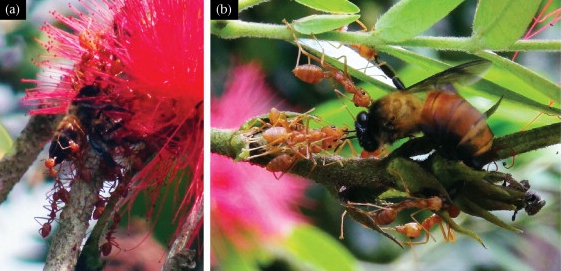
Giant Honey Bees Eavesdrop on Weaver Ants
Oct 27, 2014 Email"> PrintText Size

Eavesdropping, a type of public information use, is defined as receivers intercepting and using signals designed for other senders
Previous work of Prof. TAN Ken has shown that Asian weaver ants prey on Asian honeybees and attacked bees produce an alarm pheromone that repels nestmates from dangerous food. As flower visitors, ants rarely benefit a plant, commonly disrupting pollination by deterring other flower visitors, or stealing nectar. It remains unclear whether pollinators can eavesdrop on the odour trail pheromone signals produced by ants.
Dr. LI Jianjun and Prof. TAN Ken of Xishuangbanna Tropical Botanical Garden (XTBG) of Chinese Academy of Sciences together with other researchers, tested the hypothesis that bees have evolved the ability to eavesdrop on the trail pheromone signals of predator ants because such pheromones are much more abundant than odour cues and therefore should be easier to detect.
The researchers carried out experiments on the Asian weaver ant (Oecophylla smaragdina) and the giant Asian honeybee (Apis dorsat) as they both distributed throughout most of the Asian tropics. They aimed to determine whether ant presence (ant visual and smelling stimuli) on Calliandra haematocephala inflorescences could repel A. dorsata foragers and whether honey bees could use olfactory eavesdropping to avoid the ants' trail pheromone. After chemically analyzing O. smaragdina trail pheromone, the researchers found that honey bees eavesdropping on the most abundant chemical component of the trail pheromone.
The study found that honeybees could eavesdrop on and avoid ant trail pheromone. Weaver ants successfully preyed on giant Asian honeybees foraging at inflorescences. Bees avoided inflorescences with live ants and avoided extracts of ant trail pheromone. The results contribute to a growing understanding of how public information about predators and competitors can shape food webs, and how pollinators can tap into the private signals of predators and use this information to their advantage.
The study entitled “Giant Asian honeybees use olfactory eavesdropping to detect and avoid ant predators” has been published online in Animal Behavior.

Oecophylla smaragdina ants attacking Apis dorsata foragers on Calliandra haematocephala inflorescences: (a) Ants attacking a foraging bee at an inflorescence, (b) Ants dragging off a captured bee to the ant nest. (Image by LI Jianjun)
Eavesdropping, a type of public information use, is defined as receivers intercepting and using signals designed for other senders
Previous work of Prof. TAN Ken has shown that Asian weaver ants prey on Asian honeybees and attacked bees produce an alarm pheromone that repels nestmates from dangerous food. As flower visitors, ants rarely benefit a plant, commonly disrupting pollination by deterring other flower visitors, or stealing nectar. It remains unclear whether pollinators can eavesdrop on the odour trail pheromone signals produced by ants.
Dr. LI Jianjun and Prof. TAN Ken of Xishuangbanna Tropical Botanical Garden (XTBG) of Chinese Academy of Sciences together with other researchers, tested the hypothesis that bees have evolved the ability to eavesdrop on the trail pheromone signals of predator ants because such pheromones are much more abundant than odour cues and therefore should be easier to detect.
The researchers carried out experiments on the Asian weaver ant (Oecophylla smaragdina) and the giant Asian honeybee (Apis dorsat) as they both distributed throughout most of the Asian tropics. They aimed to determine whether ant presence (ant visual and smelling stimuli) on Calliandra haematocephala inflorescences could repel A. dorsata foragers and whether honey bees could use olfactory eavesdropping to avoid the ants' trail pheromone. After chemically analyzing O. smaragdina trail pheromone, the researchers found that honey bees eavesdropping on the most abundant chemical component of the trail pheromone.
The study found that honeybees could eavesdrop on and avoid ant trail pheromone. Weaver ants successfully preyed on giant Asian honeybees foraging at inflorescences. Bees avoided inflorescences with live ants and avoided extracts of ant trail pheromone. The results contribute to a growing understanding of how public information about predators and competitors can shape food webs, and how pollinators can tap into the private signals of predators and use this information to their advantage.
The study entitled “Giant Asian honeybees use olfactory eavesdropping to detect and avoid ant predators” has been published online in Animal Behavior.

Oecophylla smaragdina ants attacking Apis dorsata foragers on Calliandra haematocephala inflorescences: (a) Ants attacking a foraging bee at an inflorescence, (b) Ants dragging off a captured bee to the ant nest. (Image by LI Jianjun)
CAS Institutes
There are 124 Institutions directly under the CAS by the end of 2012, with 104 research institutes, five universities & supporting organizations, 12 management organizations that consist of the headquarters and branches, and three other units. Moreover, there are 25 legal entities affiliated and 22 CAS invested holding enterprisesThere are 124 I...>> more
Contact Us

Chinese Academy of Sciences
Add: 52 Sanlihe Rd., Xicheng District, Beijing, China
Postcode: 100864
Tel: 86-10-68597592 (day) 86-10-68597289 (night)
Fax: 86-10-68511095 (day) 86-10-68512458 (night)
E-mail: cas_en@cas.cn

